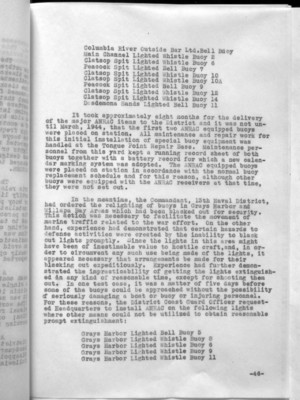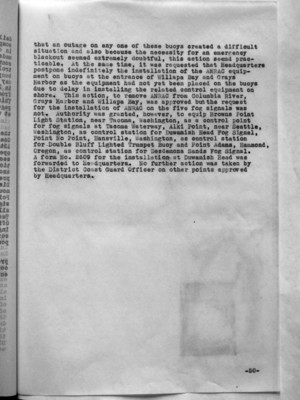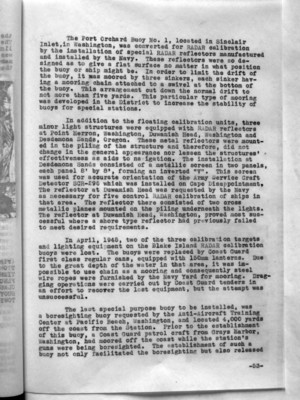Pages That Mention Desdemona Sands
Coast Guard District narrative histories 1945
66
Columbia River Outside Bar Ltd.Bell Buoy Main Channel Lighted Whistle Buoy 2 Clatsop Spit Lighted Whistle Buoy 6 Peacock Spit Lighted Bell Buoy 7 Clatsop Spit Lighted Whistle Buoy 10 Clatsop Spit Lighted Whistle Buoy 10A Peacock Spit Lighted Bell Buoy 9 Clatsop Spit Lighted Whistle Buoy 12 Clatsop Spit Lighted Whistle Buoy 14 Desdemona Sands Lighted Bell Buoy 11
It took approximately eight months for the delivery of the major ANRAC items to the District and it was not until March, 1944, that the first two ANRAC equipped buoys were placed on station. All maintenance and repair work for this initial installation of special buoy equipment was handled at the Tongue Point Repair Base. Maintenance personnel from this yard kept a running record sheet of both buoys together with a battery record for which a new calendar marking system was adopted. The ANRAC equipped buoys were placed on station in accordance with the normal buoy replacement schedule and for this reason, although other buoys were equipped with the ANRAC receivers at that time, they were not set out.
In the meantime, the Commandant, 13th Naval District, had ordered the relighting of buoys in Grays Harbor and Willapa Bay Areas which had been blacked out for security. This action was necessary to facilitate the movement of marine traffic related to the war effort. On the other hand, experience had demonstrated that certain hazards to defense activities were created by the inability to black out lights promptly. Since the lights in this area might have been of inestimable value to hostile craft, and, in order to circumvent any such use being made of the lights, it appeared necessary that arrangements be made for their blacking out expeditiously. Experience had further demonstrated the impracticability of getting the lights extinguished in any kind of reasonable time, except for shooting them out. In one test case, it was a matter of five days before some of the buoys could be approached without the possibility of seriously damaging a boat or buoy or injuring personnel. For these reasons, the District Coast Guard Officer requested Headquarters to install ANRAC on the following lights where other means could not be utilized to obtain reasonable prompt extinguishment:
Grays Harbor Lighted Bell Buoy 5 Grays Harbor Lighted Whistle Buoy 8 Grays Harbor Lighted Whistle Buoy 6 Grays Harbor Lighted Whistle Buoy 9 Grays Harbor Lighted Whistle Buoy 11
-46-
70
that an outage on any one of these buoys created a difficult situation and also because the necessity for an emergency blackout seemed extremely doubtful, this action seemed practicable. At the same time, it was requested that Headquarters postpone indefinitely the installation of the ANRAC equipment on buoys at the entrance of Willapa Bay and Grays Harbor as the equipment had not yet been placed on the buoys due to delay in installing the related control equipment on shore. This action, to remove ANRAC from Columbia River, Grays Harbor and Willapa Bay, was approved but the request for the installation of ANRAC on the five fog signals was not. Authority was granted, however, to equip Browns Point Light Station, newar Tacoma, Washington, as a control point for fog signals at Tacoma Waterway, Alki Point, near Seattle, Washington, as control station for Duwamish Head Fog Signal, Point No Point, Hansville, Washington, as control station for Double Bluff Lighted Trumpet Buoy and Point Adams, Hammond, Oregon, as control station for Desdemona Sands Fog Signal. A form No. 2609 for the installation at Duwamish Head was forwarded to Headquarters. No further action was taken by the District Coast Guard Officer on other points approved by Headquarters.
-50-
73
The Port Orchard Buoy No. 1, located in Sinclair Inlet, in Washington, was converted for RADAR calibration by the installation of special RADAR reflectors manufactured and installed by the Navy. These reflectors were so designed as to give a flat surface no matter in what position the buoy or ship might be. In order to limit the drift of the buoy, it was moored by three sinkers, each sinker having a mooring chain attached to a swivel at the bottom of the buoy. This arrangement cut down the normal drift to not more than five yards. This particular type of mooring was developed in the District to increase the stability of buoys for special stations.
In addition to the floating calibration units, three minor light structures were equipped with RADAR reflectors at Point Herron, Washington, Duwamish Head, Washington and Desdemona Sands, Oregon. These metal reflectors were mounted in the piling of the structure and therefore, did not change in the general appearance nor lessen the structures' effectiveness as aids to navigation. The installation at Desdemona Sands consisted of a metallic screen in two panels, each panel 8' by 8', forming an inverted "V". This screen was used for accurate orientation of the Army Service Craft Detector SCR-296 which was installed on Cape Disappointment. The reflector at Duwamish Head was requested by the Navy as necessary for five control RADAR calibration of ships in that area. The reflector there consisted of two cross metallic planes mounted on the piling underneath the lights. The reflector at Duwamish Head, Washington, proved most successful where a shore type reflector had previously failed to meet desired requirements.
In April, 1945, two of the three calibration targets and lighting equipment on the Blake Island RADAR calibration buoys were lost. The buoys were replaced by Coast Guard first class regular cans, equipped with 150mm lanterns. Due to the great depth of the water in that area, it was impossible to use chain as a mooring and consequently steel wire ropes were furnished by the Navy Yard for mooring. Dragging operations were carried out by Coast Guard tenders in an effort to recover the lost equipment, but the attempt was unsuccessful.
The last special purpose buoy to be installed, was a boresighting buoy requested by the Anti-Aircraft Training Center at Pacific Beach, Washington, and located 4,000 yards off the coast from the Station. Prior to the establishment of this buoy, a Coast Guard patrol craft from Grays Harbor, Washington, Had moored off the coast while the station's guns were being boresighted. The establishment of such a buoy not only facilitated the boresighting but also released
-53-


